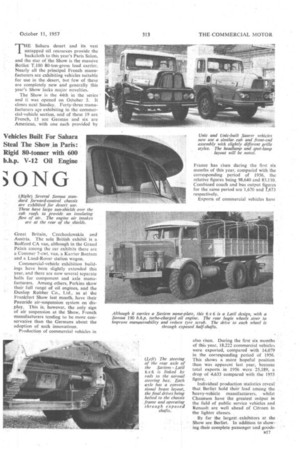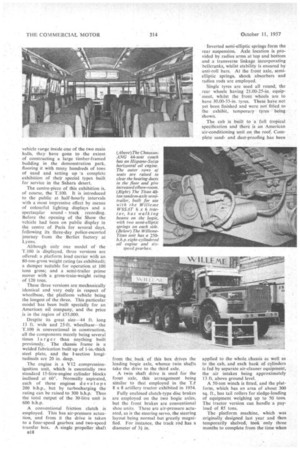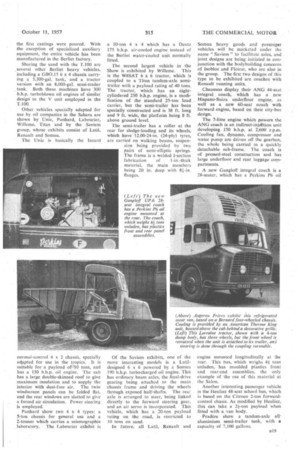DESERT ;ONG
Page 50

Page 51

Page 52

Page 53

If you've noticed an error in this article please click here to report it so we can fix it.
Great Britain, Czechoslovakia and Austria. The sole British exhibit is a Bedford CA van, although in the Grand Palais among the car exhibits there are a Commer 7-cwt, van, a Karrier Bantam and a Land-Rover station wagon.
Commercial-vehicle exhibition buildings have been slightly extended this year, and there are now several separate halls for component and axle manufacturers. Among others, Perkins show their full range of oil engines, and the Dunlop Rubber Co., Ltd., as at the Frankfurt Show last month, have their Pneuride air-suspension system on display. This is, however, the only sign of air suspension at the Show. French manufacturers tending to be more conservative than the Germans about the adoption of such innovations.
Production of commercial vehicles in also risen. During the first six months of this year, 18,222 commercial vehicles were exported, compared with 14,079 in the corresponding period of 1956. This shows a more hopeful position than was apparent last year, because total exports in 1956 were 25,189, a drop of 4,633 compared with the 1955 figure.
Individual production statistics reveal that Berliet hold their lead among the heavy-vehicle manufacturers, whilst Chausson have the greatest output in the field of public service vehicles and Renault are well ahead of Citroen in the lighter classes.
By far the largest exhibitors at the Show are Berliet. In addition to showing their complete passenger and goodsn17 vehicle range inside one of the two main halls, they have gone to • the extent of constructing a large timber-framed building in the demonstration park. flooring it with many hundreds of tons of sand and setting up 'a complete exhibition of their special types built for service in the Sahara desert.
The centre-piece of this exhibition is, of course, the T.100. It is .introduced to the public at half-hourly intervals with a most impressive effect by means of colourful lighting displays and a spectacular sound track recording. Before the opening of the Show the vehicle had been on public display in the centre of Paris for several days, following its three-day police-escorted journey from the Berliet factory at Lyons.
Although only one model of the T.100 is displayed, three versions are offered: a platform load carrier with an 80-too-gross weight rating (as exhibited); a dumper suitable for operation at 100 tons gross; and a semi-trailer prime mover with a gross-train-weight rating of 120 tons.
These three versions are mechanically identical and vary only in respect of wheelbase, the platform vehicle being the longest of the three. This particular ['tildel has been built specially for an American oil company, and the price is in the region of £55,000.
Despite its great size--44 ft. long 13 ft. wide and 25-ft. wheelbase—the T.100 is conventional in construction, all the components merely being several times larger than anything built previously. The chassis frame is a welded fabrication built up of 1.-in.-thick steel plate, and the I-section longitudinals are 20 in. deep.
The engine is a V12 .compressionignition unit, which is essentially two standard 15-litre-engine cylinder blocks inclined at 60*. Normally aspirated, each of these engines develops 200 b.h.p., but by turbocbarging the rating can be raised to 300 b.h.p. Thus the total output of the 30-litre unit is 600 b.h.p.
A conventional friction clutch is employed. This has air-pressure actuation, and from it the drive is taken to a four-speed gearbox and two-speed transfer box. A •single propeller shaft from the back of this box drives the leading bogie axle, whence twin shafts take the drive to the third axle.
A twin shaft drive is used for the front axle, this arrangement being similar to that employed in the T. 8 x 8 artillery tractor exhibited in 1954.
Fully enclased clutch-type disc brakes are employed on the two bogie axles, but the front brakes are conventional shoe units. These are air-pressure actuated, as is the steering servo, the steering layout being normal but greatly magnified. For instance, the track rod has a diameter of 31 in.
inverted semi-elliptic springs form the rear suspension. Axle location is provided by radius arms at top and bottom and a transverse linkage incorporating bellcranks, whilst stability is ensured by anti-roll bars. At the front axle, semielliptic springs, shock absorbers and radius rods are employed.
Single tyres are used all round, the rear wheels having 21.00-25-in, equipment, whilst the front wheels are to have 30.00-33-in. tyres. These have not yet been finished and were not fitted to the exhibit, 'temporary tyres being shown.
The cab is built to a full tropical specification and -there is an American air-conditioning unit on the roof. Complete sandand dust-proofing has been
applied to the whole.chassis as well as to the cab, and each bank of cylinders is fed by separate air-cleaner equipment, the air intakes being approximately 13 ft. above ground level.
A 50-ton winch is fitted, and the platform, which has an area of about 300 sq. ft., has tail rollers for sledge-loading of equipment weighing up to 50 tons. The tractor version can handle a payload of 85 tons.
The platform machine, which was originally designed last year and then temporarily shelved, took only three months to complete from the time When
the first castings were poured. With the exception of specialized auxiliary equipment, the entire vehicle has been manufactured in the Berliet factory.
Sharing the sand with the T.100 are several other Berliet heavy vehicles, including a GB0.15 6 x 4 chassis carrying a 5,300-gal. tank, and a tractor version with an 8,000-gal. semi-trailer tank. Both these machines have 300 b.h.p. turboblown oil engines of similar design to the V unit employed in the 1.100.
Other vehicles specially adapted for use by oil companies in the Sahara are shown by Unic, Panhard, Labourier, Willeme, Titan and by the Saviem group, whose exhibits consist of Latii. Renault and Somua.
The Unic is basically the Isoard normal-control 4 x 2 chassis, specially adapted for use in the tropics. It is suitable for a payload of 10 tons, and has a 150 b.h.p. oil engine. The cab has a large double-skinned roof to give maximum insulation and to supply the interior with dust-free air. The twin windscreen panels can be folded flat, and the rear windows are slatted to give a forced air circulation. Power steering is employed.
Panhard show two 4 x 4 types: a 5-ton chassis for general use and a 2-tonner which carries a seismographic laboratory. The Labourier exhibit is a 10-ton 4 x 4 which has a Deutz 175 b.h.p. air-cooled engine instead of the Berliet water-cooled unit normally fitted.
The second largest vehicle in the Show is exhibited by Willeme. This is the W8SAT 6 x 6 tractor, which is coupled to a Titan tandem-axle semitrailer with a payload rating of 40 tons. The tractor, which has an eightcylindered 250 b.h.p. engine, is a modification of the standard 25-ton load carrier, but the semi-trailer has been specially constructed and is 38 ft. long and 9 ft. wide, the platform being 8 ft. above ground level.
The semi-trailer has a roller at the rear for sledge-loading and its wheels, which have 12.00-24-in. (24-ply) tyres, are carried on walking beams, suspension being provided by two pairs of semi-elliptic springs. The frame is a welded 1-section
fabrication of 1-in.-thick material, the main members being 20 in deep with 84-in. flanges
Of the Saviern exhibits, one of the more interesting models is a Latildesigned 6 x 6 powered by a Somua 190 b.h.p. turbocharged oil engine. This has ordinary beam axles, the final-clrive gearing being attached to the main chassis frame and driving the wheels through exposed half-shafts. The rear axle is arranged to steer, being linked directly to the forward steering gear, and an air servo is incorporated. This vehicle, which has a 20-ton payload rating on the road, is restricted to 10 tons on sand.
In future, all Latil, Renault and Somua heavy goods and passenger vehicles will be marketed under the name " Saviem " to facilitate sales, and joint designs are being initiated in conjunction with the bodybuilding concerns of Isobloc and Floirat, who are also in the group. The first two designs of this type to be exhibited are coaches with Renault running units.
Chaus-son display their ANG 44-seat integral coach, Which has a new Hispano-Suiza underfloor engine, as well as a new 60-seat coach with forward engine, based on their city-bus design.
The 7-litre engine which powers the ANG coach is an indirect-inAtion unit developing 150 b.h.p. at 2,600 r.p.m. Cooling fan, dynamo, compressor and water pump are driven off the gearbox, the whole being carried in a quickly detachable sub-frame. The coach is of pressed-steel construction and has large underfloor and rear luggage compartments.
A new Gangloff integral coach is a 28-seater, which has a Perkins P6 oil engine mounted longitudinally at the rear. This bus, which weighs 44 tons unladen, has moulded plastics front and rear-end assemblies, the only example of the use of this material at the Salon.
Another interesting passenger vehicle is the Heuliez 48-seat school bus, which is based on the Citroen 2-ton forwardcontrol chasis. As modified by Heuliez, this can take a 21-ton payload when fitted with a van body.
Pradere show a tandem-axle allaluminium semi-trailer tank, with a capacity of 7,100 gallons.




















































































































